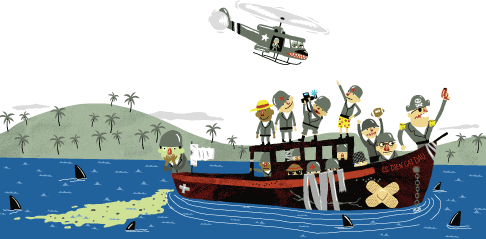 |
||||||||||||
|
May/June 2016
BY BY BEN NATION
That afternoon a motley crew assembled at the dispensary under the command of Capt. Goldsmith to promote friendly relations between Americans and the cordial and well-behaved Vietnamese of the islands. Four people were actually necessary to carry out the MEDCAP mission, yet our crew totaled fifteen. This number was necessary, believe it or not, because there was a possibility we might be attacked by a division of bad guys. Off we went to Pier Three to board our swift boat or Chris Craft cruiser or whatever it was the Navy had those days. Just tying up when we arrived was an out-and-out “whatever it was.” It was nothing like we’d ever seen before. In fact, I’ve seen sunken boats that looked in better shape than this thing. Lt. Gillis of the Navy calmly explained that the vessel was a member of the Vietnamese Junk Fleet—and a real junk it was in all respects. The old boat evidently had been around for about 50,000 years, so we figured it might last another day. Aboard we went, off to the distant isle of whatever its name was. Once at our destination, the Vietnamese immediately gathered ’round and began yelling things (probably dirty words) and waving their hands like crazy. Of course, we yelled back at them and waved like crazy. They apparently were happy to see us, and we were happy to see them—probably because we had traveled the ten miles without sinking. Medical supplies were unloaded and Doc Goldsmith and his medical quacks set up shop and began giving shots to everyone in sight. Once that was over, our team got down to serious business and began “treating” people. Those who needed a second shot even had serum put into the needles this time. Everyone else spread out, pretending to provide security. In reality, they were looking for any female they could find between the ages of fifteen and ninety; none were found. At this point, we nearly had our first friendly casualty: Spec.4 Arnold made the mistake of pulling out a pack of chewing gum. The last we saw of him, he was running for his life with what looked like a thousand kids hot on his heels. Finally, our faithless and untiring team of blood-thirsty medics finished spreading all manner of disease among the people, and it was time to go. So off we went on our return voyage. Approximately three seconds and ten feet out from shore, we noticed that the motor—“engine” I guess it’s called—had ceased to make noise and we had ceased to move. No problem, merely a blown head gasket. We needed only to replace it. Here we hit a snag: We didn’t have a replacement. Utilizing his vast skills and the helpful suggestions from our crew of accomplished nautical engineers, our Vietnamese mechanic soon had the junk underway by improvising a piece of cardboard as a gasket. We made it about three miles out—just far enough that no one could hear us—and, unless they were looking for us, no one could see us, either. Again we stopped moving—this time for good. Taking stock of our situation and applying all rules of leadership and cunning, we concluded that we had a problem. A check of supplies showed that we had one crate of lemons, two crates of onions, one crate of apples, no water, no radio, no white flag, and enough weapons and ammunition to last us six months. As the current was rather swift (determined by an ingenuous method devised by Spec.4 Alvo: He threw up over the side of the boat, and we watched the mess quickly float by), we decided to toss out the anchor. This was the high point of the day: We actually remembered to tie the rope to the anchor. We soon discovered, however, that the anchor wouldn’t reach bottom, and we continued to drift toward Charlie’s house. About four hundred yards from shore, the anchor finally caught and there we were. Next began a phase lasting several hours in which we told jokes, demonstrated against the war in Vietnam, worked on our suntans, and did other rather stupid things such as firing our machine gun to attract attention. After the chewing-gum episode, we really began to think Spec.4 Arnold had cracked when he picked up his weapon and began cleaning it. Really now, would you clean your weapon in such a situation? But he was not cleaning his weapon; instead, he was screwing together sections of cleaning rods. To this he attached the only white item on board—Capt. Welch’s t-shirt—and, lo, we had a distress flag or surrender flag, whichever we happened to need first. Still without help, we made a startling discovery: six red flares. Saved! We set off the first one. For two long minutes, thirty eyes watched its every move. Apparently the thirty eyes on board were the only eyes watching, as no one rushed to help us. Shortly before dark, however, we heard the distant sound of a helicopter. Another flare was opened and handed to Doc Goldsmith. “Here it comes. Get ready, Doc.” POW! There it goes. No, there it went. Only our doctor could shoot a flare off, have it do a 180, and nearly set his own ship on fire. By this time the chopper was past us, but we decided to try again. This time the flare worked. For one long minute nothing happened. Then, slowly, the chopper turned and came toward us. Thinking back, it’s a wonder we didn’t all have our fool heads blown off. As it was, we weren’t too sure we got our message across. Anyway, because everyone was so busy taking pictures, we forgot to signal again. One pass, however, and not too close at that, and our new-found friend headed for places unknown. Surely, he had seen our predicament and would send help. Send help he did. Not thirty minutes later, we again heard the slap-slap of a chopper heading our way, this time from Cam Ranh. Usually a helicopter is an interesting and exciting object to watch. However, there was something different about this one. Maybe it was the way in which it was coming straight at us wide open, with nineteen hundred machine guns aiming right down our throats. Ever notice how big those things look when they’re pointed at you? No sweat. He was here to rescue us. So we, in our lemon juice-inspired delirium, thought: Hah! He made his first pass several inches above our floating home, but I didn’t notice. All I could see were four beady eyes glaring at me from behind two of the biggest machine guns I’ve ever seen. No smiles, no flag waving, no joyous reunion. What was wrong with those nuts? At this point, let me interject the chopper crew’s interpretation of what was happening. At about 7 p.m., they were involved in a crucial game of Old Maid when the telephone rang. It seems that an unarmed helicopter returning from Phan Rang had been shot at, or at least something was shot, by a junkload of Viet Cong or North Vietnamese. Upon making a wide circle, a white flag was observed and since no more shots were fired, it was presumed that the VC were trying to surrender or to lure the chopper in for more sinister purposes (none of which were thought to be a friendly discussion of capitalist-communist political views). A combat-ready gunship crew—fearless champions of justice—was immediately dispatched to either accept the surrender or sink the whole bunch. The pilot later told us that had we shot off another flare, he would have fired on us with all the firepower at his disposal. It didn’t take much imagination to see our junk reduced to several million smaller pieces of junk—and us along with it. One moment of anxiety while they looked us over to see whether we were worth shooting—in our ignorance, we madly took pictures of our rescuers—and we were saved. After all, nobody but a bunch of GIs could possibly be running around in everything from jockey shorts to rolled-up fatigue pants and bush hats, taking photographs, and making tape recordings of a situation like this. Only one more incident and the adventure would be over. Would you believe a helicopter landing on a boat at sea? No? Well, we didn’t either. However, that’s almost what happened. Since we didn’t have a South Vietnamese flag, a big red “X” was supposed to signify that this was a South Vietnamese Navy boat. Apparently, however, the only people aware of this convention were the little guys who painted big red “X”s on Vietnamese boats. Determining that we weren’t the enemy and seeing the “X” on the engine cover of our unseaworthy craft, the pilot decided the “X” meant “Land Right Here”—and that’s what he almost did. But just before he touched down, our gallant naval officer scampered aboard the chopper and convinced him that landing was not such a swell idea. So, off they went back into the wild blue yonder to have a boat sent to rescue us. They sent another Vietnamese junk. And so ends the Saga of the Lost MEDCAP mission. We had no casualties (except Spec.4 Alvo’s stomach), but there were thousands of photographs, one sunburn, and a war story that probably grew into monstrous proportions in less than a week.
|
||||||||||||
|
|
||||||||||||
|
|
||||||||||||
8719 Colesville Road, Suite 100, Silver Spring. MD 20910 | www.vva.org | contact us |
||||||||||||






















 here were you between the hours of 1 and 8 p.m. on April 13, 1967? Some of us were on a Vietnamese junk, adrift on the South China Sea, stranded ten miles from friendly forces and four hundred yards from Charlie’s home.
here were you between the hours of 1 and 8 p.m. on April 13, 1967? Some of us were on a Vietnamese junk, adrift on the South China Sea, stranded ten miles from friendly forces and four hundred yards from Charlie’s home.